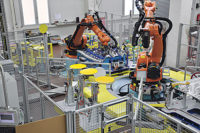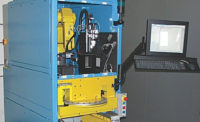There is no doubt that little things can make a big difference in electronics manufacturing. For example, using out-of-spec micro screws and bolts on commercial smart phones can wreak havoc on their assembly quality and performance reliability. The only way a manufacturer can avoid these problems is to carefully inspect these fasteners prior to assembly.
However, finding the right small-parts inspection system isn’t always easy. Tom Brennan, president at Artemis Vision, cites three common challenges: space constraints, accuracy and repeatability, and recognizing and cataloging defects.
Small-parts manufacturers often have limited space for an inspection system, which typically includes a machine vision camera, lens, light source and processing unit. Fortunately, an inspection system can be sized to specifically meet a manufacturer’s needs and space requirements.
The challenge of accuracy and repeatability can be overcome by using an automated inspection system. This system eliminates operator errors and missed defects often caused by worker fatigue. The main challenge of a manual system is maintaining a consistent method and quality level of inspection (receiving, loading, checking and removing the part) from person to person.
After implementing the inspection system, the manufacturer needs to clearly define and locate each defect. Some defects are obvious to the naked eye, while others may be so miniscule that they go unnoticed. The manufacturer must also catalog all known defects. A preprogrammed machine or human inspector can then check the part against the catalog to ensure that the part has no defects. Manual checking can be a time-consuming and costly process.
A few years ago, Artemis Vision introduced the visionStation for inspecting small parts. The station is fitted with a machine vision camera and lighting that can be tailored to the type of inspection being performed. It is an operator-loaded unit that can be used as a standalone station or integrated into an existing operation.
“The visionStation is ideal for customers who need to run approximately 20,000 parts per day or less,” says Brennan. “At 3 seconds per cycle, an operator can load about 10,000 parts per shift. [The station] is geared for customers who need flexible automation and repeatability between operators and production batches without necessarily wanting or requiring full inline automation where parts are conveyed on a belt.”
The station’s key feature is a Prosilica GT4905 machine vision camera made by Allied Vision Technologies Inc. Equipped with the OnSemi KAI-16050 Truesense CCD sensor, the camera captures 16-megapixel images of inspected parts at 7.5 frames per second through a Gigabit Ethernet interface. It also offers camera temperature monitoring, trigger over Ethernet, and power over Ethernet.
“We selected the GT4905 because of its high resolution and excellent dynamic range,” explains Brennan. “The dynamic range plays an important part when imaging the shiny areas of a part, created by the lighting source. Furthermore, the [durable camera] can handle the rigorous conditions the station may be used in.”
Comprehensive I/O functionality enables easy camera integration. The camera supports cable lengths up to 100 meters (CAT-6 is recommended). A color model (GT4905C) is also available.
For more information, call 484-881-3398 or visit www.alliedvision.com.




